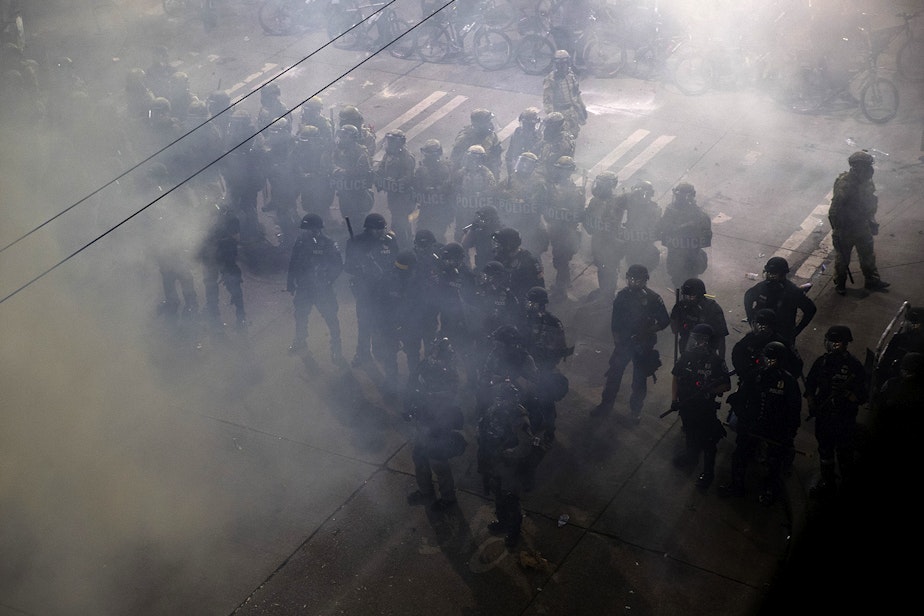Seattle police found in contempt of court over use of pepper spray, blast balls

A federal judge has found Seattle police in contempt of court for violating an order issued over the summer, limiting when they could use pepper spray, blast balls and other crowd control measures.
The judgment came in response to a motion filed by Black Lives Matter Seattle-King County. The organization accused the Seattle Police Department of violating an injunction prohibiting the use of crowd control tactics like pepper spray and blast balls on protesters.
RELATED: Needing body armor to protest in Seattle violates constitutional rights, lawsuit argues
U.S. District Judge Richard Jones announced his findings Monday, The Seattle Times reports.
The judge determined officers used the prohibited tactics four times against peaceful demonstrators between August and September. There was no immediate threat to the public or officers, however, Judge Jones concluded. At the time, the court had ordered SPD not to use the crowd control methods.
The issue stems from a lawsuit filed by BLM Seattle-King County in August. The lawsuit resulted in the court order for SPD to cease using certain crowd control methods amid ongoing protests. It is that court order which SPD is accused of violating and has resulted in the contempt of court finding.
Next week, the court may impose penalties on SPD. Judge Jones asked lawyers for BLM to submit a motion for proposed sanctions by the end of next week.
Black Lives Matter Seattle-King County said in a statement “the use of pepper spray and blast balls against our community is proof that our protests are necessary.”
On Twitter, the group further noted that "Last summer, with our partners at the ACLU and impacted protesters, we secured the original restraining order against the SPD and the City. When police didn't stop, we came back and filed a contempt of court."
Court conclusions
In his findings this week, Judge Jones writes that he grants and denies parts of city's request to reject the contempt of court allegations.
In their briefing, Plaintiffs raise a range of concerns, from general police conduct and demeanor to specific SPD tactics, such as the use of bicycles to move crowds from location to location, the towing of protestor vehicles blocking roads, and the playing of loud country music during an arrest. Plaintiffs contend that they included these details for context. For clarity, however, the Court states here: Those tactics were not and are not before this Court. They were not part of the Court’s temporary restraining order, and they are not part of the Court’s operative preliminary injunctions.
To be sure, the protests were much more complex and dynamic than set forth in this Order. Hundreds of protestors, dozens of police officers, and countless projectiles exchanged between them make it nearly impossible to render a comprehensive factual account. And the evidence provided to this Court, though robust, is imperfect. Still, despite the grey, the Court must determine by clear and convincing evidence whether the City violated this Court’s previous orders and should thereby be held in contempt.
In some cases, the judge found that SPD officers used pepper spray for no reason on protesters. Those actions led to the contempt of court findings for Aug. 27, Sept. 7, Sept. 22, and Sept. 23. In other cases, he writes that while officers may have been responding to assaults on them, their use of blast balls was not permitted because they used them indiscriminately (under the order, if an officer is threatened, they must use a blast ball targeted near the offender and not randomly on protesters).
But Judge Jones also states that officers were justified in other instances. He notes a couple encounters with protesters who used traffic cones and a broken umbrella to clash with officers, intending to do harm. Pepper balls were used in response.
In another incident, a protester struck an officer in the head, from behind, with a metal baseball bat while another person was throwing a traffic cone at him, and another was attempting to take his police bike. It was found that the use of pepper spray was justified in this encounter. The officer also hit other protesters with pepper spray as he retreated, but Judge Jones stated that given the "extreme circumstances" of this incident, the deployment was permissible.
In his conclusion, Judge Jones notes a back-and-forth pattern between protesters and police, with one group throwing items at the other, and the other group responding. In one incident outside the Seattle Police Officers' Guild office, the judge writes that protesters threw rocks, bottles, explosives, and a Molotov cocktail, which almost exploded near fellow demonstrators. After that incident, SPD says it found a box of 12 unlit Molotov cocktails from the demonstration. SPD used pepper spray, pepper balls, and blast balls during that encounter.
Judge Jones uses the clash outside the SPOG office to explain that many encounters are "too close to call" or do not have adequate evidence to determine if one party is at fault. For example, while some protesters obeyed officers' commands, others did not. Police used pepper spray on a protester who disobeyed a command, and when others went to help that protester, they also were responded to. Later that night, protesters were affected by pepper spray when they did not provoke police, yet protesters near them were throwing items at officers.


